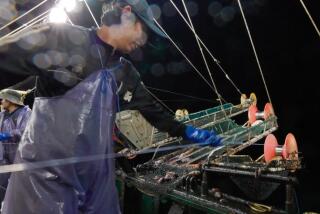Unknown Fish Becomes Star
- Share via
“Sixteen months ago, we had 5 million pounds of frozen fish fillets in a warehouse. There was no sales movement, prices were sliding and our competitors were selling the stuff at a loss--some went for as little as 50 cents a pound,” recounted Graham Redmayne.
The surplus fish in question was Alaskan pollock, a little-known seafood whose obscurity failed to interest consumers. Naturally, this unfamiliarity was also a deterrent for restaurant fish buyers.
The lack of response made it clear to Redmayne’s company, Arctic Alaska Seafoods, that America’s appetite for fish may be rapidly expanding, but only on a selective basis.
Memory of the problem still lingered as Redmayne discussed the situation while staffing an exhibit at Sea Fare ‘87, a recent trade show at the Long Beach Convention Center.
“We had 5 million pounds in storage along with new vessels out there catching more fish, but no market,” he said.
Although this meaty, white fish carries an unfamiliar name, it is the staple in the highly processed surimi mixture that is used to make the imitation crab and shrimp products that have dramatically proliferated in the past few years. Yet, there was little demand for Alaskan pollock meat in an unadulterated form--a situation that made things difficult for Redmayne and his warehouse full of boneless fillets.
But then, in early 1986, the market began to change. Most importantly, supplies of cod, the world’s most popular whitefish, became tight. A thinning catch was accompanied by heavy demand from a number of international markets. For instance, cod is a traditional presence on European tables. It also has a long-held place as the species of choice for fish and chips in England and it is widely used for fish sandwiches in this nation’s fast-food restaurants.
The cod supply-demand situation caused prices to almost double at the wholesale level. Purveyors were thus forced to look elsewhere for a similar-tasting fish with the same relative texture and color.
“The people we were beseeching to look at our product for months to no avail suddenly became receptive. They turned to pollock and it subsequently became a successful fish for them,” said Redmayne, vice president for the Seattle-based Arctic Alaska, a firm with a fleet of boats that catches, processes and freezes fish at sea.
The sudden emergence of Alaskan pollock, not to be confused with the darker-colored, oilier Atlantic Ocean species of the same last name, has been significant. Generally unknown only a matter of months ago, the fish now shows great promise as a reasonably priced whitefish with little of the supply unpredictability that plagues other species.
The movement started about 20 years ago when Alaskan pollock was selected as the basis for surimi --the heavily cooked and reformed substance used for the imitation seafood products developed by the Japanese. Sales of surimi in this country alone went from virtually nothing in 1980 to last year’s total of more than 120 million pounds.
Fishermen hoped that if consumers enjoyed imitation shellfish then they were also likely to accept its main component. But the jump from ingredient to entree did not occur until the pricing problems with cod arose. Only then was there a forced re-evaluation of Alaskan pollock, a delicately tinted fish that turns the desirable white color when cooked.
“Is Alaskan pollock the fish of the future? I think Alaskan pollock is the fish of the present,” said John Martin of Intersea Fisheries Limited of Seattle. “There is a worldwide whitefish shortage encompassing species such as cod and haddock. This situation has driven the price of traditional whitefish up really high, making Alaskan pollock much more attractive.”
The fish is caught primarily in the Bering Sea, and various industry estimates state that it may be the world’s most plentiful seafood. One analyst, in fact, said the controlled annual harvest of Alaskan pollock alone could reach as high as 4 million tons, dwarfing the total catch of cod--now estimated to be 2.2 million tons a year.
Alaskan pollock’s initial industry troubles were attributed, in part, to size. The average fish weighs about one pound and is 16 inches in length. Such smaller-size fish pose a disadvantage because they require more labor to yield edible portions. Once processed, though, fillets range in size from three to 10 ounces.
Until recently, most Alaskan pollock has been caught primarily by Japanese, Korean or Soviet vessels. But federal legislation has made it progressively easier for American fishing boats to assume a greater role within U.S. territorial waters.
“We are finally capitalizing on our own resources,” said Ted Evans, executive director of the Alaska Factory Trawler Assn., a group of about 20 independent boat owners.
Taking control was one thing, marketing was still another, Evans said.
The fish was being rejected by consumers and fish buyers because of a general perception that it was inferior and because it was confused with its less desirable Atlantic Ocean relative.
“Last year at this time we couldn’t sell the fish. But we took it to the people and let them taste it. With our efforts coming at the same time as the shortage of cod, people eventually opened their minds and pollock filled a void,” Evans said.
Negative impressions no longer being the case, Evans estimates that the number of boats that will concentrate on Alaskan pollock will quickly increase.
Evidence for the expansion came when the fish’s proponents scored their biggest victory to date. Just a few months ago, Skipper’s, a restaurant chain with outlets in Northern California, decided to make the switch from cod to Alaskan pollock for its fried fish dishes.
Redmayne, Evans and others expect more conversions in the weeks ahead. They also project that the fish will become more readily available at supermarket fish counters.
“Most consumers don’t know about Alaskan pollock right now,” Evans said. “But everyone is looking for whitefish today. And, so, for us it is just a matter of targeting a market and going after it.”
More to Read
Sign up for Essential California
The most important California stories and recommendations in your inbox every morning.
You may occasionally receive promotional content from the Los Angeles Times.









